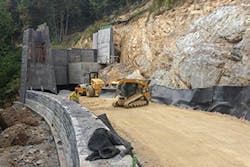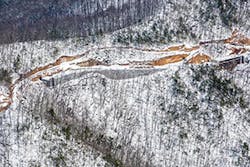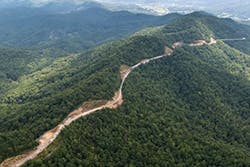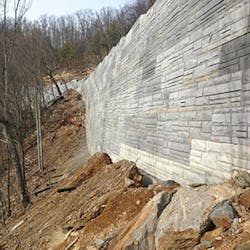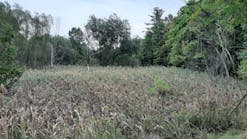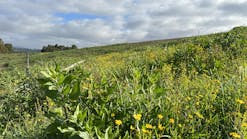Editor’s Note: This article first appeared in the March-April 2016 issue of Erosion Control.
They’ve been around for thousands of years. They can shore up a backyard flowerbed or a 200-foot-high bridge trestle. They can be made by hand or require multistory cranes. They’re not very exciting dinner topics, but they are becoming pretty good looking, some say beautiful. What are these humble servants of engineering? They’re retaining walls, and they are often the key component required to “hold it all together” when building a feature that disrupts the natural landscape.
While retaining wall technology has evolved, their primary function to hold back earth has changed little over the centuries. Innovations in modern engineering have made the traditional materials of stone, cement, and mortars combine with the latest products to perform near miracles.
Progress on the “missing link” section of the
Foothills Parkway
One of the most well-known retaining walls—although we don’t always think of it as such—is the two-millennia-old Great Wall of China, which is not one but a series of double-sided retaining walls several thousand miles long, built in phases. While the wall was originally ordered built by Emperor Qin to keep out unwanted invaders and not to control erosion, it has nonetheless stood the test of time. The basic structure of these double-walled structures, made of cut quarried stone and fieldstone, filled with packed earth and branches in between, and held together with mortar, is not all that different from the sophisticated technologies of the 21st century.
Progress on the “missing link” section of the
Foothills Parkway
Foothills Parkway
Closer to home is another long-term retaining wall project, and while it hasn’t taken thousands of years to build, this national parkway in Tennessee—originally authorized during World War II—has waited for decades to be completed. Two segments of road, with an elevation of 3,100 feet at the summit, have gone unfinished since the 1970s. They are separated by less than 2 miles of what some say is the most difficult engineering project of their career. Now, the Foothills Parkway in the Great Smoky Mountains of Tennessee—part of the Appalachian trail—is on its way to completion at last, and installing the extremely steep retaining walls to support multiple bridges is the key factor.
“Back then they used hand-chiseled granite,” says Eric Barger, of Tennessee-based Barger and Sons, a licensed producer of Stone Strong retaining wall products that are now being used to finish the project. To replicate the look of the original, says Barger, the company used a three-dimensional scan of the original existing wall and fashioned laser formliners that perfectly replicate the original texture to make facsimile patterns. The Stone Strong block is poured concrete that has color added to the mix to match the color of the original wall. When installed, he says, they are placed in a horizontal, random, non-repeating pattern.
“Each block is 24 square feet, and it looks exactly like the original granite in shape, texture, and color, but without the intensive labor and expense of hand-cut granite.”
Barger says more than 80,000 square feet of retaining wall will be installed in total, and with each block weighing in at 6,000 pounds, it is an engineering feat to construct walls he describes as approaching 50 feet in height. The challenging installation is being performed by The Lane Construction Corp. of Walland.
“We’re now doing the very last mile, known as the ‘Missing Link,'” says Tom Meador, Lane’s project manager. “Erecting the Stone Strong walls is like putting together a Tinkertoy—they are all interlocking. But first you have to excavate far enough back to both support the wall and accommodate the geogrid reinforcement laterally, and once you get that excavated down, then you build up.”
Meador says each row is a different length, dependent on the terrain, with several bottom layers being embedded and then backfilled.
He says Lane selected Synteen geogrid, which is engineered to provide exceptional strength for retaining walls. The company offers products suitable for steep slopes and projects like this one with technically challenging angles.
“The Lane people came to us, and we met with their engineers to figure out the product best suited to meet their needs,” says Synteen general manager Kim Roberts. “The engineers look at the type of soil condition, what kind of soil you’re working with, the final height of the wall, and the amount of surcharge on top. Some retaining walls have buildings on top of them; in this case, it was a road and had to support passing cars. They calculated the strength required to be used with a particular type of block, and we ended up using our SF 110 geogrid for the walls of this roadway, which is at the high end of our tensile strength geogrid.”
Roberts explains that this particular high-tenacity polyester product has a 1-inch by 1-inch grid. “This material is coated with PVC to encapsulate it, which acts as an insulation protecting it from water wicking that could break down the fibers, and gives it added flexibility and strength as well,” he says.
The geogrid has a tensile strength of 10,000 pounds per square foot, which is key to supporting the earth backfill and preventing erosion, soil loss, and soil breakdown—particularly important for the very tall retaining walls of the Parkway. The geogrid helps cut down on the amount of aggregate needed and anchors the walls back into the earth. But for all its technical benefits, it’s as easy to use as a roll of big box store garden support.
“It’s lightweight and easy to cut with a utility knife; it doesn’t need any special tools, labor, or application process. Basically, you put your blocks down, pile your fill behind it, then lay a blanket of this geogrid on the block and roll it out as far back as the engineered excavating specifies. Then do your next layer of blocks, and repeat the process as often as the engineering specifies.”
So far, the project has used about 75,000 square yards of Synteen geogrid, says Roberts. Company CEO Glenn Steen adds some geogrid backstory. He says geosynthetics have been around for decades, but the proliferation of geogrids really began in the 1990s as more universities developed geotechnical programs and produced engineers who have added to the innovations of today’s market. One of the company’s high-strength fabrics, made of woven fiberglass and used for levee repair, is so strong that a foot-wide piece, says Steen, “would hold up a dozen cars.”
He adds that the contribution of the company’s Lancaster, SC, textile company to this project is a fitting legacy. “Textiles have been the heartbeat of this community for generations, but with the departure of the garment market, we are one of the few remaining textile companies left. It just seems fitting that we are contributing to the legacy of this historic national project with a product made and manufactured just a few hours from the parkway. We have contributed to some great high-profile projects by the US Army Corps of Engineers, the US Forest Service, the Federal Highway Administration, and more. We’re very proud of being a ‘made in the USA’ company,” says Steen.
One Foot Out, One Foot Down
